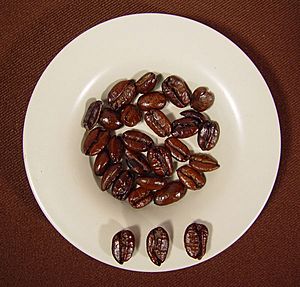Kapeng barako facts for kids
Kapeng barako is a special kind of coffee grown in the Philippines. It's also known as Barako coffee or Batangas coffee. This coffee comes from the Coffea liberica plant species. You'll find it mostly in the provinces of Batangas and Cavite.
The word Barako in Filipino languages means "stud". It's often linked to ideas of strength and being tough. Barako coffee is famous for its strong taste and a smell that reminds some people of anise.
Barako coffee trees are very big, making them a bit harder to grow than other coffee types. Because of this, and lower demand, this coffee is considered endangered. It's even listed in the Ark of Taste, which is a list of important but endangered foods from around the world. This list is kept by the Slow Food movement.
Contents
What Does "Barako" Mean?
The word Barako in Philippine languages is like the English word "stud". It comes from the Spanish word varraco, which means "wild boar". In Filipino culture, the word Barako is connected to ideas of strength and being manly.
History of Barako Coffee
Barako coffee first came to the Philippines in the 1740s. Spanish friars brought it and planted it in the low areas of Lipa, Batangas. From there, it spread to other parts of Batangas. Soon, Batangas became well-known for its coffee.
In the 1860s, Barako coffee was even sent to other countries. It went to San Francisco in the United States and to parts of Europe. This coffee was very valuable, selling for five times more than other Asian coffee beans. By 1876, Barako coffee was also being grown in the nearby province of Cavite.
The Philippines became one of the top four coffee producers in the world in the 1880s. This happened because a plant disease called coffee rust had damaged coffee farms everywhere else. However, in 1889, the coffee industry in the Philippines also suffered. Coffee rust spread to the islands, causing most farmers to stop growing coffee. They switched to other crops instead.
Only a few Barako coffee plants survived, mostly in Cavite. In the middle of the 20th century, people wanted more coffee again. But Barako coffee didn't become popular again. This was because it was hard to grow compared to other coffee types. Instead, new types of coffee that could resist coffee rust were brought in from the United States.
About Barako Coffee Beans and Trees
The beans of the liberica coffee plant are quite special. Unlike other common coffee beans like arabica or robusta, liberica beans are not even on both sides. One side is shorter, which makes a small "hook" shape at the tip. The line down the middle of the bean is also more bumpy.
Barako coffee trees are very tall. They can grow up to 20 meters (about 65 feet) high! Because they are so tall, farmers need to use ladders to pick the coffee cherries. The cherries, the beans, and even the leaves of Barako coffee trees are some of the biggest among all coffee types.
Many people say that Barako coffee tastes better than Robusta coffee. Most Philippine coffee drinkers prefer Barako over Arabica coffee. Sometimes, Barako is mixed with Arabica or Excelsa coffee. These mixtures create a wider range of flavors. Barako coffee has a unique taste and a strong smell that reminds people of anise.
Growing and Protecting Barako Coffee
Today, Barako coffee makes up less than 2% of all the coffee grown for sale. Most of it comes from small farms in the Philippines. It's not often sent to other countries. Instead, it's sold to local people and tourists. Some Barako coffee is also grown in Malaysia.
Because Barako trees are so big, it's not as easy or efficient to grow and harvest them compared to other coffee types. This is why most modern farmers choose to grow robusta coffee instead. However, there's a growing interest in bringing Barako coffee back. More and more local coffee shops in the Philippines are starting to use it.
Barako coffee is listed in the Ark of Taste. This is an international list of endangered traditional foods. It's part of an effort by the Slow Food movement to protect important food heritage.
How to Prepare Barako Coffee
Barako coffee can be made in a few ways. You can use a drip brew coffee maker or a French press. Some people simply pour hot water over the coffee grounds and then filter the mixture using a piece of cloth.
Traditionally, Barako coffee is enjoyed black. Sometimes, it's sweetened with muscovado sugar, which is a type of unrefined brown sugar. Barako coffee can also be used to make espresso and other drinks that use espresso.
Other Uses for Barako Coffee
Besides being a delicious drink, kapeng barako has other uses too! It's sometimes used as a body scrub in spa treatments. In Batangas, people sometimes use kapeng barako as a kind of soup with their rice dishes. This is common when they eat tapa or other dry, fried foods. Kapeng barako from Batangas is becoming more popular because of its unique, real, and traditional feel.



